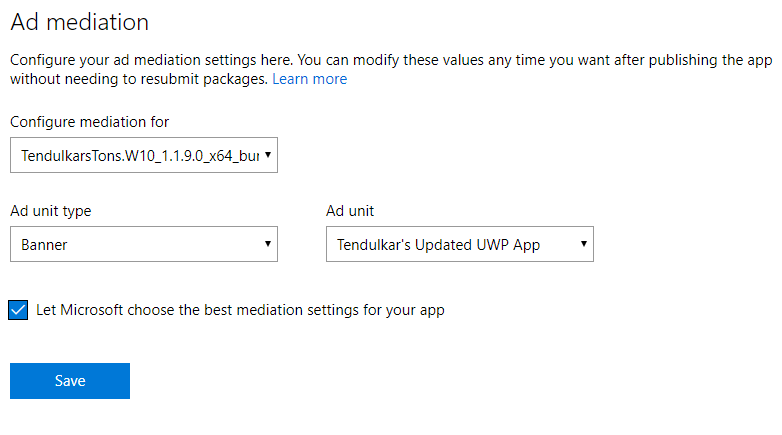Understanding the ad mediation configuration in the Microsoft ad mediation service

We announced the general availability of the Microsoft ad mediation service in May 2017. The federated cloud based ad mediation service is designed to help app developers maximize their ad revenue. In this blog post, we will go deeper into the mechanics of how a developer can configure their ad network choices to achieve the best possible yield.
Configuring mediation for your application
Developers can setup ad mediation in the Windows Dev center for their ad enabled applications. The ad mediation service mediates ad requests between a plethora of ad networks. The mediation configuration UX in the Monetize with Ads page for an application provides the developer control over managing the mediation configuration for that application.
Microsoft optimized configuration
The default option that is selected is for Microsoft to choose the best mediation settings for the app. This allows the machine learning algorithms that we employ to make ad requests to the best possible available ad networks to ensure highest yield for the developers.
The yield management algorithms use a mixture of User Profile (Age/Gender, Behavioral Segmentation, Location, Time of the day, Day of the week, Ad Engagement Rate), Publisher quality score (Ad Size, Ad Format, Ad Placement, Similar Apps, Category, CTR, Viewability Signals, Quality Score) and Historical data score (Historical CPM, Historical Sell-through Rate) parameters for their computation.
The machine learning algorithm looks at various parameters to compute the waterfall order of the ad partners that would get the maximum yield for the application developer.
It is strongly recommended that developers choose this default option for maximizing yield for their ad enabled apps.
Manual configuration
A developer can also manually configure the rank order of the ad networks to serve ads on a given ad unit. These selections can be done across all markets or can be customized for specific markets. When the option for letting Microsoft choose the best mediation settings is unselected, the list of available ad networks and their order is shown. The developer can play around with these settings and set it up to their desired values, including setting specific order for different markets. They can also remove ad networks from the waterfall by toggling the ‘Active’ checkbox in the configuration UX, as shown below.
If you notice the choice of networks here, you can see the presence of both paid and other (non-paid) ad networks. The percentages indicate the percentage of times the ad request will be sent to the ‘type’ of ad networks first. The percentages allow for the developer to allocate between paid and non-paid ad networks. This gives them flexibility to play with the type of ads being shown based on their requirements. For example, if a developer wants to use a given week to just promote their app, they can mark the paid ads to 0% and non-paid House and Community ads to 100%.
In the above screenshot, the ad request would be sent first to the other ad networks 30% first before it would be sent to the paid networks. If the developer does not have any House or Community ad campaigns setup, no ads would be returned for them.
Although it is recommended that developers use the Microsoft optimized configuration option, there are a few advanced scenarios in which a developer would choose to go with a manual configuration:
- The developer wants to exclude a few ad networks from serving
- The developer wants to tweak the ratio of paid and free ads
- The developer wants specific configuration for different markets
The configuration can be changed once per day and takes a couple of hours to take effect. Developers can learn more about configuring their ad unit for optimal yield here.
Examining the performance of the various ad networks in the Analytics page can help the developer choose the method of configuration for their ad networks.
We hope this gives you insight into how you can use the ad mediation service to increase your yield. Please let us know if you have any questions or comments!
Source: Understanding the ad mediation configuration in the Microsoft ad mediation service